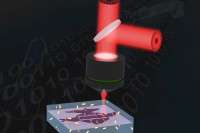Nano breakthrough boosts data security

(Phys.org) -- The growing e-security issue is being tackled through nanotechnology at Swinburne University of Technology.
Breakthrough research jointly completed by the researchers Professor Min Gu and Dr. Xiangping Li of Swinburne University and a visiting PhD student from National Chiao Tung University,Taiwan, has demonstrated a novel means of encrypting data for secure electronic storage.
The researchers have developed a unique approach to aiming a laser beam that will enable increased data storage capacity as well as the ability to encrypt information on DVDs coated with gold nanorods.
"Information security is a key issue for organisations," Professor Min Gu said.
"As technology evolves, the need for secure electronic data storage becomes more and more acute," he added.
Professor Min Gu is a Laureate Fellow of the Australian Research Council who has funded this project since 2010.
"Our research shows that encryption coding could be applied to gold nanorods lying in any plane on the recorded material."
Traditional electronic data storage methods use three physical dimensions. Two additional methods for recording information use polarisation and the colour spectrum. Both methods use nanotechnology in which Swinburne is a world leader.
"If you look at a recorded disc under a microscope you will see tiny dots. These dots store information or data that is read by the laser in a CD player or DVD player. Previously this information could only be read in a flat plane," Dr. Xiangping Li said.
The researchers projected different wavelengths of light onto tiny gold nanorods in the disc to record and read data on the material.
These nanorods are particles so small that 500 of them end-to-end could fit across a human hair. They have been used in a wide range of applications because of their unique optical and photothermal properties and can be tuned to a specific light frequency.
The polarisation technique uses the electric field present in each light wave. When light waves are projected onto the material, the direction of the electric field aligns certain particles in the optical material, allowing data to be stored on them.
When the direction of the incoming light wave is altered, the changing electric field will align a different set of particles. Many light waves of different polarizations will result in every particle storing optical data.
"Instead of having a beam in a straight plane (a vector), the team has been able to make that beam rotated on any plane, with infinite control so now they can make that beam polarised in any direction and then they can tune the light frequency," Gu said.
"The new technique creates a truly unique way of aiming a beam of light so that it only reacts to very specific sets of particles."
The research also paves the way for attacking cancer cells with ultra-high medical safety.
These tiny gold nanorods can also be triggered by a laser beam to blast holes in the membranes of tumour cells to destroy cancer.
The research has been published online in Nature Communications.
Journal information: Nature Communications
Provided by Swinburne University of Technology




















